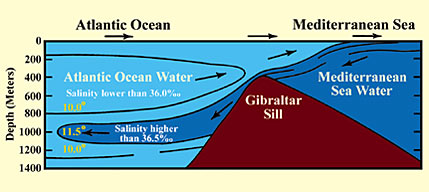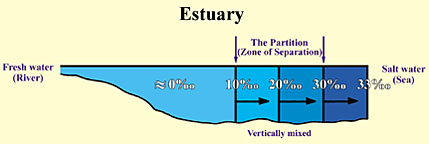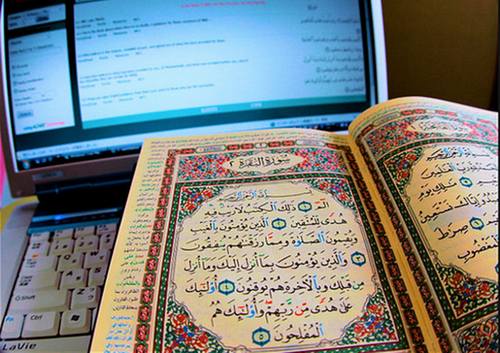The Quran on Seas and Rivers:Modern Science has discovered that in the places where two different seas meet, there is a barrier between them. This barrier divides the two seas so that each sea has its own temperature, salinity, and density.1 For example, Mediterranean sea water is warm, saline, and less dense, compared to Atlantic ocean water. When Mediterranean sea water enters the Atlantic over the Gibraltar sill, it moves several hundred kilometers into the Atlantic at a depth of about 1000 meters with its own warm, saline, and less dense characteristics. The Mediterranean water stabilizes at this depth2 (see figure 13).
พระคัมภีร์กุรอานว่าด้วยทะเลและแม่น้ำ | ||||||
วิทยาศาสตร์สมัยใหม่ได้ค้นพบว่า ในสถานที่ซึ่งทะเลสองสายมาบรรจบกัน จะเกิดสิ่งขวางกั้นทะเลทั้งสองไว้ โดยที่สิ่งขวางกั้นดังกล่าวนี้จะแบ่งทะเลทั้งสองออกจากกัน เพื่อที่ว่าทะเลแต่ละสายจะได้มีอุณหภูมิ ความเข้มและความหนาแน่นเป็นของตนเอง.1 ตัวอย่างเช่น น้ำในทะเลเมดิเตอร์เรเนียนจะอุ่น เค็ม และมีความหนาแน่นน้อยเมื่อเทียบกับน้ำในมหาสมุทรแอตแลนติก เมื่อน้ำในทะเลเมดิเตอร์เรเนียนหนุนเข้าไปในมหาสมุทรแอตแลนติค โดยผ่านทางสันดอนยิบรอลตาร์ (Gibraltar) มันจะไหลไปเป็นระยะทางหลายร้อยกิโลเมตรหนุนเข้าไปในมหาสมุทรแอตแลนติกที่ความลึกประมาณ 1000 เมตร โดยพาความอุ่น ความเค็ม และความหนาแน่นที่น้อยกว่าของมันเองไปด้วย น้ำในทะเลเมดิเตอร์เรเนียนจะคงที่อยู่ที่ความลึกดังกล่าวนี้2(ดูรูปที่ 13). |
รูปที่ 13:น้ำจากทะเลเมดิเตอร์เรเนียนขณะที่หนุนเข้าไปในมหาสมุทรแอตแลนติกโดยผ่านทางสันดอนยิบรอลตาร์ ซึ่งจะพาความอุ่น ความเค็มและความหนาแน่นที่น้อยกว่าเข้าไปด้วยเนื่องมาจากแนวสันดอนที่กั้นอยู่แบ่งแยกความแตกต่างระหว่างทะเลทั้งสอง อุณหภูมิจะนับเป็นองศาเซลเซียส (C’) (Marine Geology ของ Kuenen หน้า 43 ฉบับปรับปรุงเพิ่มเติมเล็กน้อย) (คลิกที่รูปภาพเพื่อขยายใหญ่) |
แม้ว่าจะมีคลื่นลูกใหญ่ กระแสน้ำที่เชี่ยวกราก และระดับน้ำขึ้นลงสูงเพียงใดในทะเลดังกล่าว ทะเลทั้งสองก็จะไม่มีโอกาสที่จะรวมกันหรือรุกล้ำสิ่งขวางกั้นนี้ไปได้ .
พระคัมภีร์กุรอานได้กล่าวไว้ว่า มีสิ่งขวางกั้นระหว่างทะเลทั้งสองที่มาบรรจบกัน และทะเลทั้งสองจะไม่สามารถรุกล้ำผ่านไปได้ พระผู้เป็นเจ้าทรงตรัสว่า:
"พระองค์ทรงทำให้น่านน้ำทั้งสองไหลมาบรรจบกันระหว่างมันทั้งสองมีที่กั้นกีดขวาง มันจะไม่ล้ำเขตต่อกัน. " (พระคัมภีร์กุรอาน, 55:19-20)
แต่เมื่อพระคัมภีร์กุรอานกล่าวถึงเรื่องราวระหว่างน้ำจืดกับน้ำเค็ม พระคัมภีร์มักจะกล่าวว่าจะมี “เขตหวงห้าม” โดยมีสิ่งขวางกั้นไม่ให้น้ำทั้งสองรวมกันได้ พระผู้เป็นเจ้าทรงตรัสไว้ในพระคัมภีร์กุรอานดังน:
" และพระองค์คือผู้ทรงทำให้ทะเลทั้งสองบรรจบติดกัน อันนี้จืดสนิทและอันนี้เค็มจัดและทรงทำที่คั่นระหว่างมันทั้งสอง และที่กั้นขวางอันแน่นหนา. " (พระคัมภีร์กุรอาน, 25:53)
อาจมีใครบางคนถามว่า ทำไมพระคัมภีร์กุรอานจึงกล่าวถึงการแบ่งเขต เมื่อพูดถึงเรื่องสิ่งที่แบ่งแยกระหว่างน้ำจืดกับน้ำเค็ม แต่ไม่กล่าวถึงการแบ่งเขตดังกล่าวเมื่อพูดถึงสิ่งที่แบ่งแยกระหว่างทะเลสองสาย?
วิทยาศาสตร์สมัยใหม่ได้ค้นพบว่าในบริเวณปากแม่น้ำ ที่ซึ่งน้ำจืดและน้ำเค็มมาบรรจบกันนั้น สถานภาพจะค่อนข้างแตกต่างจากสิ่งที่ได้พบในสถานที่ซึ่งทะเลสองสายมาบรรจบกัน โดยพบว่าสิ่งที่แยกน้ำจืดออกจากน้ำเค็มในบริเวณปากแม่น้ำนั้นคือ “เขตที่น้ำเปลี่ยนแปลงความหนาแน่น โดยที่ความหนาแน่นที่แตกต่างกันอย่างชัดเจนจะเป็นสิ่งที่แยกน้ำสองสายนี้ออกเป็นสองชั้น.”3 การแบ่งเขตดังกล่าวนี้ (เขตการแบ่งแยก) จะมีความแตกต่างในเรื่องของความเค็มระหว่างน้ำจืดและน้ำเค็ม4 (ดูรูปที่ 14).
รูปท 14:ส่วนที่เป็นเส้นตั้งตรง แสดงให้เห็นถึงความเค็ม (ส่วน ต่อ หนึ่งพันเปอร์เซ็นต์) ในบริเวณปากแม่น้ำ เราจะเห็นการแบ่งเขต (เขตการแบ่งแยก) ที่กั้นระหว่างน้ำจืดกับน้ำเค็ม (Introductory Oceanography ของ Thurman หน้า 301 ฉบับปรับปรุงเพิ่มเติมเล็กน้อย) (คลิกที่รูปภาพเพื่อขยายใหญ่) |
ข้อมูลดังกล่าวได้ถูกค้นพบเมื่อไม่นานมานี้ โดยการใช้เครื่องมือที่ทันสมัยในการวัดอุณหภูมิ ความเค็ม ความหนาแน่น ออกซิเจนที่ไม่ละลายน้ำ และอื่นๆ ด้วยสายตาของมนุษย์จะไม่สามารถมองเห็นความแตกต่างระหว่างการมาบรรจบกันของทะเลทั้งสองสายได้ ซึ่งทะเลทั้งสองที่ปรากฏต่อหน้าเรานั้นดูเหมือนเป็นทะเลพื้นเดียวกัน เช่นเดียวกันที่สายตาของมนุษย์ไม่สามารถมองเห็นการแยกกันของน้ำในบริเวณปากแม่น้ำที่ผสมผสานกันของน้ำ 3 ชนิด ได้แก่ น้ำจืด น้ำเค็ม และการแบ่งเขต (เขตการแบ่งแยก).
_____________________________
เชิงอรรถ:
(1)Principles of Oceanography ของ Davis หน้า 92-93. 
(2)Principles of Oceanography ของ Davis หน้า 93. 
(3)Oceanography ของ Gross หน้า 242 และดูที่ Introductory Oceanography ของ Thurman หน้า 300-301. 
(4)Oceanography ของ Gross หน้า 244 และ Introductory Oceanography ของ Thurman หน้า 300-301. 








